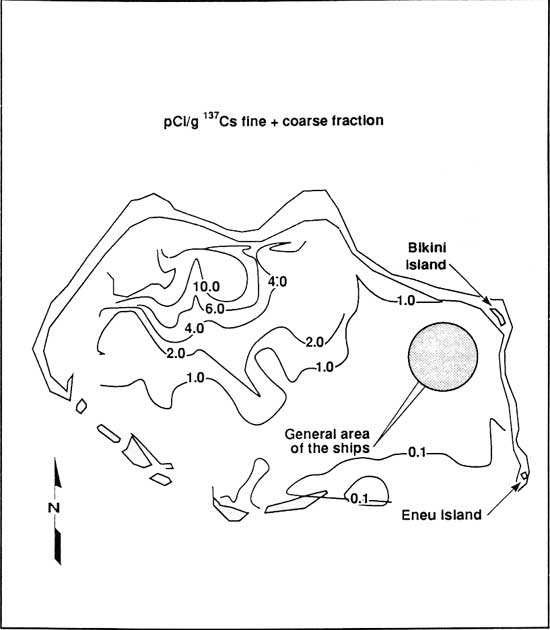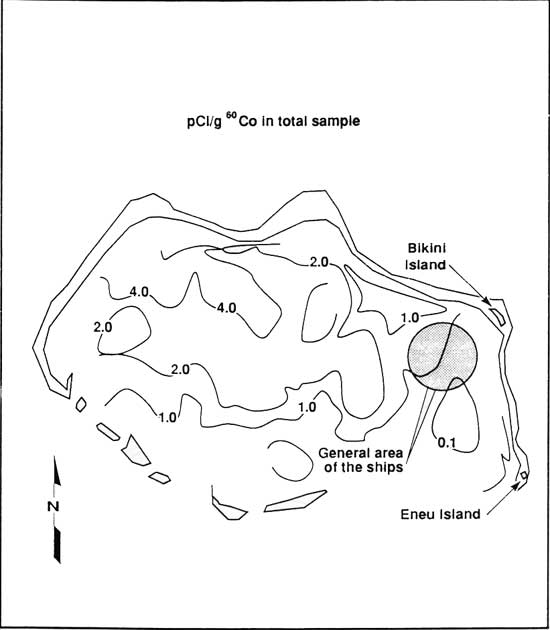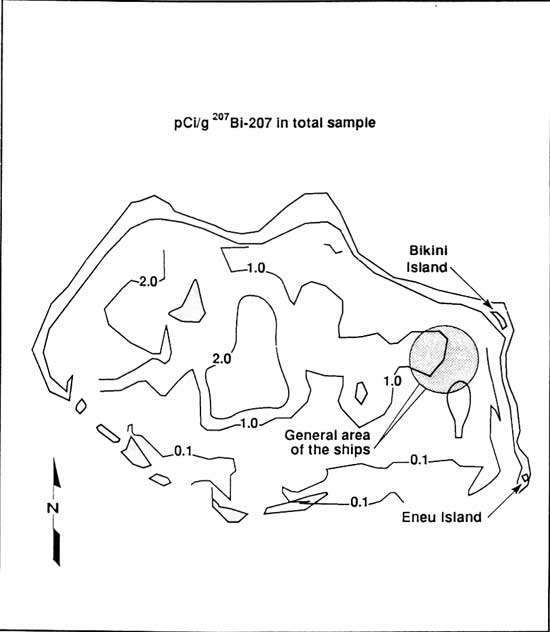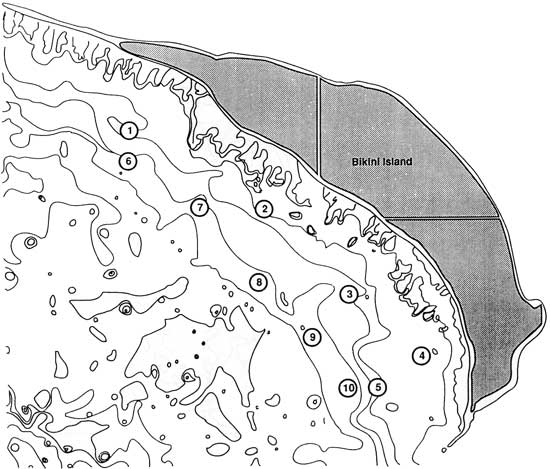|
National Park Service
The Archeology of the Atomic Bomb A Submerged Cultural Resources Assessment of the Sunken Fleet of Operation Crossroads at Bikini and Kwajalein Atoll Lagoons |

|
APPENDIX III: ESTIMATES OF THE RADIOLOGICAL DOSE TO PEOPLE LIVING ON BIKINI ISLAND FOR TWO WEEKS WHILE DIVING IN AND AROUND THE SUNKEN SHIPS IN BIKINI LAGOON
Introduction
Bikini Island and Bikini Lagoon were contaminated by fallout from nuclear weapons tests conducted at the atoll by the United States from 1946 to 1958. The second test, Baker, of the Crossroads series was an underwater detonation in 1946 that sank several ships in the lagoon, including the USS Saratoga and the Japanese battleship Nagato.
The ships received high-intensity gamma-ray and neutron bombardment from the Baker test, which induced radioactivity in the metal structures. Some of the tests conducted after the Baker shot (there were 21 tests in all) injected contaminated carbonate particles into the air, some of which were deposited across the lagoon surface. Most of this contaminated soil then settled onto the ships' decks and other structures and on the lagoon bottom.
These sunken ships provide an interesting location for divers. Recreational diving and swimming in and around the ships raises the question of the potential radiological dose from the radionuclides present in or on the ships and in the lagoon sediments.
In addition, radionuclides were deposited on the islands. We have spent several years evaluating the radiological conditions on Bikini and Eneu Islands at Bikini Atoll and Enjebi Island at Enewetak Atoll, and estimating the radiological dose people might receive living on these islands (1-8). As a result, we have the data to also evaluate the radiological dose people would receive if they were to live on Bikini Island for a two-week period while diving near the sunken ships in the lagoon.
The purpose of this paper, therefore, is to present an analysis of the potential radiological dose to persons who would dive near the sunken ships and live on Bikini Island for a short period of time.
The Radiological Dose while in the Lagoon and around the Ships
Radionuclides in the Sediment
Many of the radionuclides produced at detonation and induced in the ships' structure (by the resulting neutron flux) have very short half-lives, (T1/2), ranging from seconds to a few weeks. Consequently, most of the radioactivity decayed away very early. Those radionuclides with half-lives in the range of several years or more are the only ones still present and that have the potential of causing exposure.
The estimates of the radiological dose will be calculated for 1990 which is 44 years after the Baker test and 32 years after the last test at Bikini Atoll. (Any dose received after 1990 would be lower.) The radionuclides currently present in the lagoon sediments and on the islands are Cesium—137 (137Cs; T1/2 = 30 years), Strontium—90 (90Sr; T1/2 = 28 years), Cobalt—60 (60Co; T1/2 = 5.3 years), Plutonium209 (239Pu; T1/2 = 24065 years), Plutonium—240 (240Pu; T1/2 = 6537 years), and Americium—240 (241Am; T1/2 = 432 years). We rarely can detect other radionuclides in island soil; however, in lagoon sediments, we often detect one of the Europium nuclides or 207Bi. Moreover, even 60Co is found in very low concentrations because it has been through at least 6 half-lives from 1958 to 1990 and even more from 1946.
Gamma-Emitting Radionuclides (137Cs and 60Co)
The average 137Cs, 60Co, and 207Bi concentrations in the lagoon sediment around the sunken-ship area are between 0.1 and 1.0 pCi/g (for sampling locations see Figures 1 — 3). These unpublished data are from an extensive survey of the radionuclide concentrations in the sediments across Bikini lagoon conducted by Dr. Victor Noshkin of the Lawrence Livermore National Laboratory (LLNL) in 1979 and 1983.

|
| Figure 1. Cesium-137 concentration contours in the lagoon surface sediments at Bikini Atoll in 1979. |

|
| Figure 2. Cobalt-60 concentration contours in the lagoon surface sediments at Bikini Atoll in 1979. |

|
| Figure 3. Bismuth-207 Concentration contours in the lagoon surface sediments at Bikini Atoll in 1979. |
Additional sediment samples were collected between Bikini Island and the sunken ships in December 1983. The locations of the samples are shown in Figure 4. The results from the analysis of these samples are listed in Table 1. The concentration of 137Cs is below 0.2 pCi/g for all samples and below 0.1 pCi/g for most samples.

|
| Figure 4. The locations of sediment areas collected in 1983 near Bikini and Eneu Islands at Bikini Atoll. (click on image for a PDF version) |
Table 1. Concentrations of 137Cs (in pCi/g dry weight) for sediments collected near Bikini Island.
| Site No. | Core Depth cm |
137Cs | Site No. | Core Depth cm |
137Cs |
| 1 | 0-25 | 0.03 | 8 | 0-10 | 0.13 |
| 25-50 | 0.04 | 10-20 | <0.08 | ||
| 2 | 0-25 | 0.10 | 20-30 | <0.07 | |
| 25-50 | 0.03 | 30-37 | <0.07 | ||
| 3 | 0-25 | 0.03 | 9 | 0-10 | <0.07 |
| 25-50 | 0.03 | 10-20 | <0.08 | ||
| 6 | 0-25 | 0.08 | 20-30 | <0.06 | |
| 7 | 0-25 | 0.09 | 30-40 | <0.08 | |
| 25-50 | 0.06 | 40-50 | 0.13 | ||
| 4A | 0-10 | <0.06 | 50-60 | <0.07 | |
| 10-20 | <0.07 | 60-70 | <0.09 | ||
| 20-30 | 0.16 | 70-75 | <0.07 | ||
| 30-40 | <0.05 | 10 | 0-10 | <0.06 | |
| 40-47 | <0.08 | 10-20 | <0.08 | ||
| 4B | 0-10 | 0.16 | 20-30 | <0.07 | |
| 10-20 | <0.08 | 30-40 | <0.07 | ||
| 20-30 | <0.08 | 40-50 | <0.06 | ||
| 30-37 | <0.09 | 50-60 | <0.08 | ||
| 5 | 0-10 | <0.07 | 60-70 | <0.08 | |
| 10-20 | <0.07 | 70-80 | <0.09 | ||
| 20-30 | <0.08 | 80-90 | <0.06 | ||
| 30-40 | <0.07 | 90-100 | <0.08 | ||
| 40-50 | 0.14 | ||||
| 50-60 | <0.06 | ||||
| 60-65 | <0.06 | ||||
Samples of sediment and algae plus fine, rusty metal were collected from several of the sunken ships in 1989 by a Navy dive team. The samples were analyzed at LLNL and the results are listed in Table 2. The 137Cs, 60Co, 155Eu, and 207Bi concentrations are generally about a few tenths of a pCi/g only two samples from the hanger deck of the Saratoga showed higher concentrations of 60Co and 207Bi.
Table 2 Analytical results for samples taken from the sunken ships in Bikini Lagoon
| Type of Sample | Location of Sample |
Radionuclide Concentration, pCi/g | ||||
| Co-60 | Cs-l37 | Eu-155 | Bi-207 | Am-241 | ||
| Algae + Rust | from Gilliam | <0.01 | <0.01 | <0.19 | <0.01 | <3.45 |
| Sediment | Gilliam Stern | 0.78 | 0.17 | 0.66 | 0.96 | 10.9 |
| Sediment | Gilliam Starboard Beam | 0.09 | 0.17 | 0.38 | 0.25 | 6.7 |
| Sediment | Gilliam Starboard Inboard Beam | 0.17 | 0.13 | 0.34 | 0.32 | 4.6 |
| Sediment | Gilliam Bow | 0.67 | 0.13 | 0.63 | 0.67 | 13.0 |
| Sediment | Gilliam Stern Outboard | 0.06 | 0.13 | 0.42 | 0.29 | 4.2 |
| Sediment | Gilliam Port Beam | 0.84 | 0.16 | 0.64 | 0.94 | 11.8 |
| Algae + Rust | from Pilot Fish | 0.36 | 0.11 | 0.09 | 0.42 | 0.9 |
| Algae + Rust | EOD Collection Pilot Fish | 0.27 | 0.14 | 0.15 | 0.50 | 2.3 |
| Wood | from Pilot Fish | 0.11 | 0.18 | <0.05 | 0.17 | 1.1 |
| Elec. Wire | Electrical Wire from Pilot Fish | <0.12 | <0.11 | <0.28 | <0.09 | <0.4 |
| Algae + Rust | from Carlisle | 0.49 | 0.08 | <0.04 | 0.47 | 1.4 |
| Sediment | Carlisle | 1.16 | 0.21 | 0.44 | 1.24 | 6.1 |
| Sediment | Saratoga Hanger | 10.82 | 0.88 | 2.75 | 14.22 | 56.5 |
| Sediment | Saratoga Fight Deck | 2.18 | 0.26 | 1.07 | 3.79 | 14.4 |
| Algae + Rust | Saratoga Hanger | 0.20 | 0.47 | <0.29 | 0.18 | <0.4 |
| Sediment | Arkansas Port Side | 0.06 | 0.08 | 0.43 | 0.17 | 8.7 |
| Sediment | Arkansas Bow | 0.10 | 0.16 | 0.38 | 0.24 | 7.1 |
| Algae + Rust | Arkansas | 0.38 | 0.14 | 0.17 | 0.49 | 1.7 |
| Sediment | Arkansas Starboard Midship | <0.02 | <0.03 | 0.16 | 0.18 | 3.5 |
| Sediment | Arkansas Port Bow | 0.09 | 0.14 | 0.32 | 0.15 | 4.9 |
| Sediment | Arkansas Stern Outboard | 0.12 | 0.07 | 0.32 | 0.28 | 5.1 |
| Sediment | Arkansas Stern Inboard | 0.11 | 0.08 | 0.38 | 0.30 | 5.0 |
| Algae + Rust | Nagato | 0.41 | 0.26 | 0.17 | 0.29 | 3.3 |
The gamma-emitting radionuclide concentrations observed in the sediment samples from all of these sources are very low ranging between 0.03 and 1 pCi/g for 137Cs. For perspective, the average concentration of 137Cs in the surface soil across the United States due to world-wide fallout ranges from about 0.4 to 1.2 pCi/g. For additional perspective, the 137Cs concentration in lagoon sediment is much less than the 137Cs concentration in surface soil in the United Kingdom and Northern Europe from the Chernobyl accident (9).
In addition, the gamma rays associated with 137Cs, 60Co, and 207Bi are attenuated exponentially as they traverse through water. The half-thickness, i.e., the thickness of water that will attenuate half of the radiation, is about 10 cm (4 inches) of water (10). Consequently, the dose from 137Cs, 60Co and 207Bi in the sediments on the ships and in the lagoon bottom while swimming near the ships is so low that it is, for all practical purposes, zero. The dose to a person on land anywhere in the world for a specific period of time would be higher than the dose from swimming in the lagoon and diving near the ships for the same period of time.
Alpha, Beta, and Very Low Energy Gamma Emitting Radionuclides
The concentration of 241Am in the sediments from the ships is higher than for the other radionuclides and ranges from 1 to 50 pCi/g. We have sufficient data on the ratios of 239+240Pu to 241Am at the atoll to know that the 239+240Pu concentration would be about 20% higher than the 241Am. The concentration of 90Sr in the lagoon sediment would be expected to be somewhat higher than the 137Cs concentration.
The other radionuclides found in the sediments are 240Am, 239+241Pu, 90Sr and europium—155 (155Eu). The primary radiation from 90Sr and 155Eu is beta particles, which can only penetrate a few millimeters of water. Plutonium and 241Am are primarily alpha particle emitters and can only penetrate a few microns (1 micron = 0.0001 cm) of water. The x radiation or gamma radiation associated with these nuclides are so low energy that they too do not penetrate any significant distance in water. Consequently. radionuclides such as 239+240Pu, 241Am, 90Sr, and 155Eu do not contribute to underwater external exposure because the emanating radiations are totally absorbed in a few millimeters or less of water and thus cannot expose people swimming nearby.
The primary potential route of exposure of people from alpha- and beta-emitting radionuclides is by inhalation. There is no chance of inhalation of these radionuclides while diving on the ships or swimming in the lagoon near the ships. The other potential route of exposure is ingestion and it is not as significant a pathway as inhalation; it is unlikely that a diver would ingest sediment. Even if small amounts of sediment could be ingested through the mask and regulator, the intake would not be significant and the very low transfer of plutonium and americium across the gut wall to the blood (fraction ingested transferred to blood = 0.001) would produce an insignificant dose.
Activation Products in the Ships
The activation products produced by the neutron flux from the Baker test interacting with the steel, iron, and other metals of the ships all have a short half-life. Most of the activation products have long since decayed and are no longer present. The major activation product that is still present is 60Co, with a half-life of 5.27 years. Consequently, the 60Co produced at the time of detonation in 1946 has decayed to 0.35% of its original value; in other words, it is also essentially gone or will be in very few more years. If diving does not begin at Bikini until 1995 or 1996, then 60Co will have decayed one whole half-life, or by 50%, from the values listed in Table 2. In the same time period, 137Cs will have decayed by another 13%. The 60Co observed in the samples listed in Table 2 are primarily the result of 60Co induced in the metal components of the ship and the subsequent deterioration and oxidation producing a fine, rusty material that spalls from the metal surfaces and becomes mixed with the sediment and algae on the ships and lagoon bottom.
The very short half-life associated with activation products has essentially eliminated them as an exposure source over the last 43 years. The small gamma flux still present is absorbed by the water as described in the previous section.
Summary of the Potential Radiological Dose while Swimming in Bikini Lagoon
The potential dose to a person swimming in the Bikini Lagoon around or through the sunken ships is so low from both the activation products originally induced in the ships and from radionuclides in the lagoon sediment that it can be considered essentially zero.
The Radiological Dose while Living on Bikini Island for Two Weeks
Inhalation Dose
The only radionuclides on the island that are of any significance via the inhalation pathway are 239+240Pu and 241Am. The dose from 137Cs and 90Sr are of no consequence, being 4 or more orders of magnitude less than plutonium and americium via inhalation (11).
The estimated effective committed dose equivalent for 239+240Pu and 241Am at Bikini Atoll is based on resuspension studies conducted at Bikini Atoll (12). The estimate is based on a scenario of 9 hours on the island in a resting state in which 4.8 m3 of air are breathed, 5 hours active time in which 6.0 m3 of air are breathed, and 10 hours on or near the lagoon and beaches, which are not relevant to inhalation of resuspended Pu or Am.
The calculated committed effective dose equivalent for a two-week stay on Bikini Island is 0.02 mrem for 239+240Pu. The contribution from 241Am would be about 70% of the plutonium dose, or about 0.014 mrem. The total effective committed dose equivalent is, therefore, 0.03 mrem. For perspective, the annual committed dose equivalent in the United States is 300 mrem/y. For additional perspective, the increased dose equivalent received flying at altitude in a jet aircraft for about 8000 miles is 4 mrem (9).
External Gamma Dose
The external gamma dose equivalent rate from 137Cs on Bikini Island is estimated to be about 11.8 mrem/year. This estimate is based on a scenario of 12 hours every day inside the schoolhouse (bunk and mess hall building), 4 hours/day around the schoolhouse, 1 hour/day in the interior of the island, and 7 hours/day in or on the lagoon. Consequently, for a person visiting for only two weeks, the dose equivalent would be about 0.45 mrem. For perspective, this can be compared to the U.S. background committed dose equivalent rate of 300 mrem/year or about 12 mrem/2 weeks.
Summary of the Total on Island Radiological Dose
The estimated effective committed dose equivalent for two weeks residence on Bikini Island or the United States are listed in Table 3. The net result is that the estimated dose for Bikini Island, for the scenario outlined above including natural background, is about 1/10 that for a similar period of residence in the United States.
Table 3. The estimated dose equivalent for two weeks at Bikini Island and the average United States.
| Committed Effective Dose Equivalent, mrem/2 weeks residence | ||
| Source | Marshall Islands | United States |
| Natural Background | 0.85 | 12 |
| 137Cs External | 0.45 | -- |
| 239+240Pu + 241Am Inhalation | 0.03 | -- |
| Total | ~1.3 | 12 |
References
1. W.L. Robison, V.E. Noshkin, W.A. Phillips, and R.J. Eagle, The Northern Marshall Islands Radiological Surveys: Radionuclide Concentrations in Fish and Clams and Estimated Doses Via the Marine Pathway, Lawrence Livermore National Laboratory, Livermore, CA, UCRL-52853, Part 3 (1981).
2. W.L. Robison, M.E. Mount, W.A. Phillips, M.L. Stuart, S.E. Thompson, and A.C. Stokes, An Updated Radiological Dose Assessment of Bikini and Eneu Islands at Bikini Atoll, Lawrence Livermore National Laboratory, Livermore, CA, UCRL-53225 (1982).
3. W.L. Robison, M.E. Mount, W.A. Phillips, C.A. Conrado, M.L. Stuart, and C.E. Stoker, The Northern Marshall Islands Radiological Survey: Terrestrial Food Chain and Total Doses, Lawrence Livermore National Laboratory Report, Livermore, CA, UCRL-52853 Part 4 (1982).
4. W.L. Robison, "Radiological Dose Assessments of Atolls in the Northern Marshall Islands," in Proc. Nineteenth Annual Meeting of the National Council on Radiation Protection and Measurements: Environmental Radioactivity, No. 5 (National Council on Radiation Protection and Measurements, Bethesda, MD, 1983), pp. 40-82.
5. W.L. Robison, C.L. Conrado, and W.A. Phillips, Enjebi Island Dose Assessment, Lawrence Livermore National Laboratory, Livermore, CA, UCRL-53805 (1987).
6. W.L. Robison, C.L.. Conrado, and M.L. Stuart, Radiological Conditions at Bikini Atoll: Radionuclide Concentrations in Vegetation, Soil, Animals, Cistern Water, and Ground Water, Lawrence Livermore National Laboratory, Livermore, CA, UCRL-53840 (1988).
7. W.L. Robison and W.A. Phillips, Estimates of the Radiological Dose from Ingestion of 137Cs and 90Sr to Infants, Children, and Adults in the Marshall Islands, Lawrence Livermore National Laboratory, Livermore, CA, UCRL-53917.
8. J.H. Shinn, D.N. Homan, and W.L. Robison, Resuspension Studies at Bikini Atoll, Lawrence Livermore National Laboratory, Livermore, CA, UCID-18538, Rev. 1 (1989).
9. United Nations Scientific Committee on the Effects of Atomic Radiation, Sources, Effects and Risks of Ionizing Radiations (United Nations, New York, 1988).
10. Robley D. Evans, The Atomic Nucleus (McGraw-Hill, New York, 1955).
11. International Commission on Radiological Protection, Limits for Intakes of Radionuclide by Workers, Pergamon Press, New Your, Pub. 30, Part I and Supp. (1979).
12. J. H. Shinn, D. N. Homan, and W. L. Robison, Resuspension Studies at Bikini Atoll, Lawrence Livermore National Laboratory, Livermore, CA, UCID-18538 (1980).
| <<< Previous | <<< Contents>>> | Next >>> |
swcr/37/app3.htm
Last Updated: 22-Sep-2008